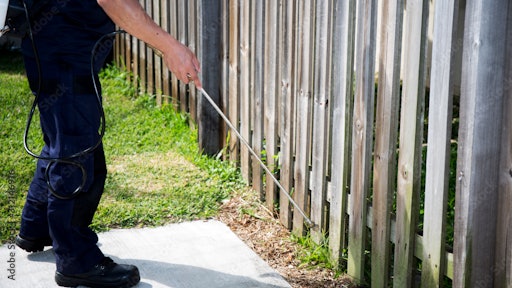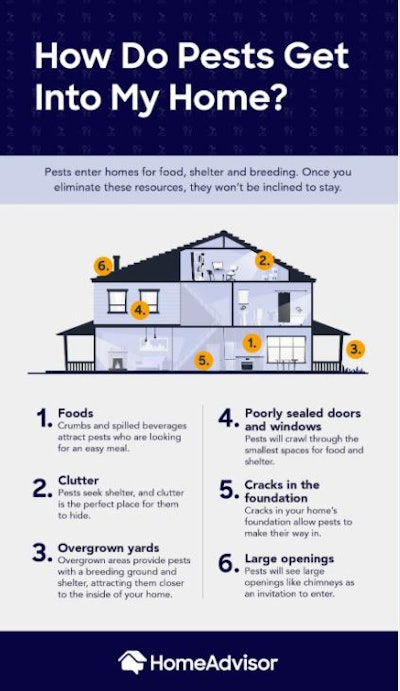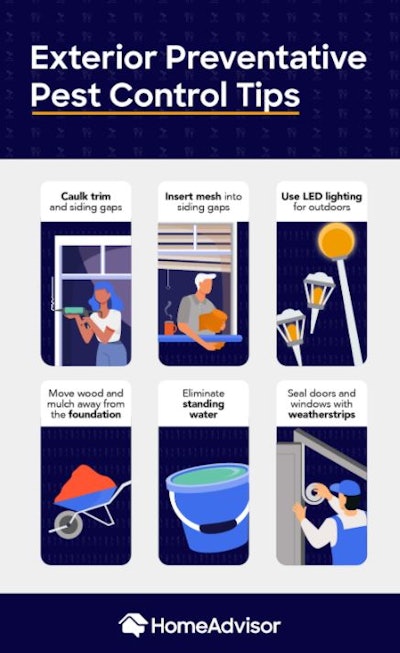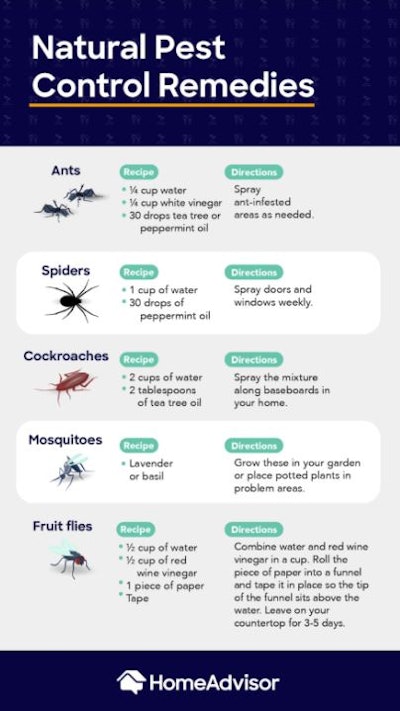
Landscapers are often some of the first to spot pests and signs of pest problems. Many times, large infestations are better left to professional pest control services. However, there are plenty of steps that landscapers can take to help homeowners avoid unnecessary damage and headaches from outdoor pests.
With that thought in mind, here’s the landscaper’s guide to outdoor pest control.
 Home Advisor
Home Advisor
Identify Problem Areas
Keep an eye out for features that create prime pest real estate during your routine work. Look for:
- Overgrown yards, especially near the house
- Foundation cracks or damage to the siding
- Clutter around the house, including wood piles
- Overly damp areas, including leaf piles and standing water
All of these can either harbor pests, or allow them easy access into a house. Routine landscaping, though, will eliminate many of these problems. A well-maintained yard will not only make it easier to keep pests at bay, but it will also help the yard stay healthy, deterring many of them in the first place.
Be sure to eliminate or refresh any standing water you see. This includes birdbaths and pools, if they fall under your service. Bodies of water such as these make perfect breeding grounds for mosquitoes. Keep the water clean and regularly refreshed to keep egg hatching to a minimum.
Also, look out for easy food sources that may be drawing pests to the home. Piles of wood will attract termites. And unsecured trash bins will be calling in all manner of unwanted guests, from rodents to the neighborhood’s stray cats.
For items that you can’t fix, including foundation issues or holes in roofs and siding, always let the homeowner know. If you offer pest control options, now would be the time. Even if you run into a large infestation, attempt to curb the problem. Removing debris, wood, and weeds from around the house will also help expose entry points that professionals can treat.
Look for Signs of Pests
Another sound option for pest control is to look for signs of the vermin themselves. Depending on the pest, you will notice telltale signs of habitation and infestation. To start, you’ll need to understand the pests common to the area. Identifying the pest is the first step to treating the problem. For example, chewed holes by the ground could be an obvious sign of rodent entry. And excessive termite damage will be visible if near an exterior wood source.
It also pays to keep up with current pest conditions and forecasts. This year, the midwest has seen an explosion of armyworms, commonly found in the south. They are known for their telltale destruction of lawns by browning and scalping entire sections. With a keen eye, a landscaper should be able to spot these nuisance caterpillars.
Many common vermin will leave few visible outdoor signs. Fleas, for example, are nearly invisible unless on a light-colored background. Insects like ants and fruit flies will be best treated indoors with natural remedies, even though they come in from outdoors.
Proper treatment begins with prevention. Identifying signs of pests should become a routine aspect of any landscaping job. Get close to the action and dive into those dark corners. Remember, though, not every critter you see will be a pest; you just want to keep them outside.
 Home Advisor
Home Advisor
Repair and Fill Entry Points
If you have the knowledge, go the extra step and repair the easy access points for pests. Often, entrances can be sealed with minimal work or materials. For example:
- Trim and siding gaps can be quickly caulked and sealed.
- Gaps in the siding can be blocked with mesh sleeves.
- Doors and windows should be sealed with weatherstripping.
- Large openings, including soffit gaps, should be filled with expanding spray foam.
Be sure to remove any mulch from around the client’s house, as it offers plenty of free food for termites and carpenter ants, and it retains moisture. This will attract not just centipedes and spiders, but also the animals that eat them. Turning mulch routinely will keep it dried out. If possible, though, keep mulch, shrubs, and gardens away from the house and foundation.
Next, take a look at the client’s outdoor lights. Old bulbs glow hot and bright. Understandably, this is exactly what flying insects are attracted to. Switch outdoor lighting to warm-colored but cool-glowing LED lights. Position them close to the ground to avoid attracting flying insects, especially moths and other night critters.
If you’re working on the client’s trees, take a look at the roof. Check for visible damage that could allow in pests, including squirrels. Use foam to fill gaps in the upper siding. Mesh screens also block out decorative framing in which hive-building pests like to build.
Speaking of trees, consider removing overhanging limbs that allow rodents easy access to the roof. While trees can be a touchy subject, squirrels can cause considerable damage to structures and landscaping. Getting rid of a limb here and there might be worth it.
 Home Advisor
Home Advisor
Treat Infestations With Safety in Mind
In the end, no amount of prevention will fix an infestation. If you come across an infestation, first, assess the size. A line of ants walking into a window trim gap can be stamped out with the liberal application of vinegar and peppermint oil at the entry points. However, if you notice outward termite damage, it might be worth consulting an expert to assess the potential for structural harm.
Many pest treatments begin outside. Fleas are nuisances that are nearly invisible unless viewed against a light surface. But, they can be treated with an application of nematodes across the yard. Mosquitoes can be kept at bay with strategically-grown lavender and basil plants.
It might be beneficial to become certified pesticide applicators, especially if you are regularly finding and treating pest problems. Nearly 45% of landscaping contractors offer pesticide applications. It makes sense. As stated above, landscapers are often the first to view emerging problems. So, who better to treat these problems than those at the front lines?
Obtaining a commercial pesticide applicator’s license requires specific knowledge of procedures, chemicals, and the pests themselves. Governed by the EPA, pesticide applicators will need to be knowledgeable in at least the following categories:
- Pesticide safety (including label knowledge, PPE, and hazard knowledge)
- Pesticide formulation and application techniques
- Laws and regulations
- Pest identification
It will also be beneficial to focus on the areas that you normally service. For example, suppose your clients are mainly located in residential neighborhoods. In that case, it makes sense to certify in ornamental and turf pest control. Likewise, urban and industrial settings would benefit from an employee well-versed in public health pest control.
Bundling pest services with landscaping services is a sound idea. Pests can impede a landscaping job. And if you’re staring a potential problem in the face on a routine basis, it makes sense to be the one to treat it.
Landscapers can be the first set of eyes to identify and eliminate a pest problem. Look for the telltale signs. Then, remove or fix issues that can lead to pest problems, including wood piles or mulch against the house. Quick repairs such as filling gaps with spray foam or meshing over siding holes can make all the difference. And, if you find yourself routinely treating pest problems while out on the job, become a certified pesticide applicator. You can even focus on organic and earth-friendly applications.






























